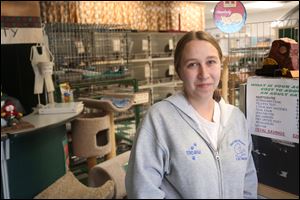
Overload of cats and kittens strains area animal shelters
Some places get 50 requests a day to drop off felines
12/16/2013
Kim Ferguson, kennel supervisor at Paws and Whiskers Cat Shelter, stands among stacks of cages of cats and kittens awaiting adoption. The shelter is full, with some 90 animals.
Amid the onset of wintry weather, area animal shelters remain packed with cats and kittens in what many are calling an unusual year for the feline population.
“Spring and fall used to be the busy times, but we’re still getting calls here in December about newborn kittens,” said Helen Bensch, executive director of the Toledo Animal Shelter.
PHOTO GALLERY: Cats pack animal shelters
The no-kill shelter on Toledo’s west side is full with 16 cats in its main cat room, six semiferal kittens in holding for medical quarantine and socialization, and four kittens in foster care.
The shelter is receiving dozens of calls daily about cats and kittens, Ms. Bensch said.
“There’s times where we’ve had to turn away 50 people a day,” she said. “There’s only so much you can do when you’re limited on space.”
Every available space at Paws and Whiskers Cat Shelter, also on the west side of the city, is filled with cats as well. While the rescue shelter tries to keep its cat population between 50 and 70, it is home now to about 90. At least 10 calls a day come in about cats.
In addition, “We have a lot that get dumped in boxes out front,” shelter manager David Plunkett said.
The shelter is accustomed to being full, and has had more than 100 cats at times, but the way the space filled up this year has been unusual.
“We’ve had this many cats in December before, but that was because we had a very busy spring and summer and were working the population down,” Mr. Plunkett said. “This time, it’s because of the fall.”
Humane Ohio, the spay/neuter clinic on Toledo’s north side, works with communities to trap, spay/neuter, and return feral felines to their colonies. So far this year, the clinic has performed 3,334 such surgeries, up more than 600 from the 2,719 spay/neuter surgeries on feral cats in 2012.
“We usually do not see kittens this far into the winter,” founder and director Aimee St. Arnaud said. “By the fall, it usually starts to slow down. We’re absolutely still seeing a lot of young kittens being brought in and we don’t know why.”
Kristy Kissoff, development coordinator at Humane Ohio, theorized a mild 2012-13 winter combined with a pleasant fall this year meant an early and extended breeding season.
“It’s just been really odd,” she said. “Kitten season never really seemed to slow down. We’ve been receiving constant calls about kittens in cat colonies.”
Ms. Bensch and Ms. St. Arnaud theorized that economics also has played a role in the high feline population for shelters.
“We had all of those foreclosures and half of them are still sitting empty,” Ms. Bensch said. “So our pool to adopt to has decreased significantly.”
“It could also be something with people having to move and leave cats behind, not being able to take care of them,” Ms. St. Arnaud said.
For Humane Ohio, Ms. St. Arnaud said she likes to think of the positive side of the increase in spay/neuter surgeries for feral cats.
“What’s really great is we are seeing more people being aware of the outdoor cats and wanting to do something about it,” she said. “We’re seeing a lot of people getting involved and that could be reflected in our numbers.”
Female cats can breed as young as 4 months old and as many as three times a year with an average of four kittens per litter, according to the American Society for the Prevention of Cruelty to Animals.
Contact Alexandra Mester at: amester@theblade.com, 419-724-6066, or on Twitter @AlexMesterBlade.